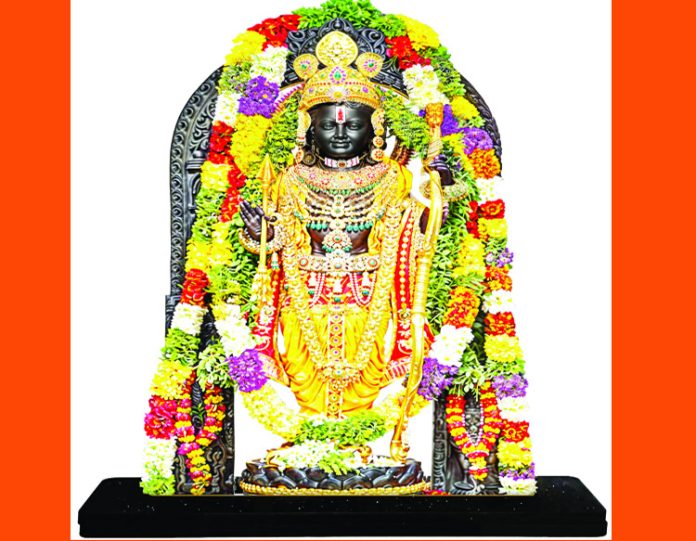 The Daily Excelsior is starting Recalling Ram– a weekly column by Suman K Sharma from this Sunday. Today, we are publishing the introductory article to let readers have a synoptic view of the series. -Editor
The Daily Excelsior is starting Recalling Ram– a weekly column by Suman K Sharma from this Sunday. Today, we are publishing the introductory article to let readers have a synoptic view of the series. -Editor
You and I; in fact, all human beings, face, at some time or the other, issues that seem intractable. On such troubled occasions the devout amongst us pray for divine help and guidance. The others seek some kind of relief thinking that they are not alone in facing the big questions of human condition. In Ram we have someone who is both divine and a mortal like us. As Lord Vishnu, He is the Ultimate; yet, as Raja Dashrath’s eldest son, He willingly imposes on himself the straitjacket of Maryada Purushottam, the best-man-ever bound by limitations. That raises before him unending questions about kinship and bonding, the dichotomy between the role of a man as a ruler and that of a family man, the relationship between man and the Deity, adherence to one’s principles and the heavy price one has to pay for that, and so on. Recalling Ram is thus to recognise the mind-boggling ways the Creator adopts to establish His will in this mortal world. Sant Tulsidas has put it aptly:
Hari anant Hari katha Ananta, kehahin sunehin bahubidhi sab santa
Ramchandra ke charit suhaye, kalap koti lagi jahin na gaye
Hari’s doings are beyond comprehension; so are His tales. The pious ones tell and hear Hari’s tales in diverse ways. Crores of aeons are not enough to sing Ramchandra’s auspicious praises.
Ramcharitmanas, Balkand, 139(iii)
It was Rishi Balmiki (‘Valmiki’ in Sanskrit) who first gave Ram’s tale an epic shape and called it ‘Ramayan’, which literally means ‘relating to Ram’. The ancient poet opens the epic narrating how he chanced to write it. Narad Muni had imparted to him the knowledge about the scion of the Ikshvaku dynasty “who is renowned in the public by the name of Ram…”After the ever-wandering celestial sage had departed, Balmiki went along with his pupil, Bharadwaj, to the river Tamsa for a bath. As he was getting ready for a dip in the holy river, he witnessed a moving spectacle. A pair of beautiful cranes were dancing amorously on the river bank. The male crane was lost in the desire for its partner. Then a hunter appeared on the scene from nowhere and shot the male crane with his arrow. The poor creature fell down on earth, helplessly fluttering its wings. Seeing its bleeding mate in death throes, the female crane cried out piteously. Balmiki could not contain himself at the sight. Words of wrathful distress fell from his lips-
Ma nishad pratishtham tvamgmah shashvatih samah
Yt kronchmithunadekamvadhih kam-mohitam
O hunter! May you never ever find peace, because you have slayed without any offence one (partner) of this pair of cranes who was bewildered with passion!
-Balmiki Ramayan, Balkand, Canto 2(xv)
Presently, Balmiki got agitated by the immensity of two disparate thoughts. He had grievously cursed a man for killing a lovelorn bird, and the way he had verbalised his curse was a shloka! It had eight words in each of its two steps and could be sung to the accompaniment of veena. His pupil, Bharadwaj, affirmed that his spontaneous utterance was indeed a shloka. The thought preoccupied Balmiki even as he returned to his ashram. There, Lord Brahma, who is the source of all learning, appeared before him. The divinity not only confirmed that it was He who had put the words into his mouth, He went on also to order Balmiki to put down in writing all that Narad had told him about Ram.
Balmiki Ramayan indeed has been called ‘kavyabijam sanatanam’ – the seed of all poetry. Rishi Ved Vyasa, the legendry author of ‘Mahabharata’, got inspired by it. There have been numerous retellings of the epic, including Sant Tulsidas’ ‘Ramcharitmanas’. The Bhakti movement poet (1532-1623) acknowledges his primary debt to the ‘Ramayan’. His is an Awadhi iteration of Balmiki’s epic. It shows a diversity of Sanskrit shlokas, dohas, chhands, sorthas, and of course, chaupayees – all eminently meaningful and amenable to be set to music. Tulsidas is able to strike a balance between the needs of poetry and the progression of his narrative by frequently resorting to dialogical device: much of the narrative is carried further by dialogues between Shiv-Parvati, Muni Yagyavalkya-Muni Bharadwaj and Kag Bhushundi-Garud.
His stylistic distinctiveness apart, Sant Tulsidas appears more focussed on the main theme of Sita-Ram than the ‘Adikavi’ Balmiki is. While the ‘Adikavi’ completed his narrative in 500 cantos comprising more than 24,000 shlokas, Tulsidas composed his retelling in a relatively concise manner. There are a host of digressions in Balmiki’s Ramayan (as we shall see in the subsequent additions to this column) that make it more like a compendium of ancient myths and legends than a narrative exclusively devoted to the Maryada Purshottam Ram. Tulsidas, on the other hand, uses the digressions – if any – only to fill in the gaps of the story. Significantly, the two poets, writing thousands of years apart in two different languages, have adopted different approaches towards Ram. While Balmiki generally treats him as a human being who has godly attributes; for Sant Tulsidas, He is God who appeared on Earth in human form to eliminate Rakshasas.
In the present column an attempt will be made to present a composite narration based on the Balmiki’s ‘Ramayan’ and the ‘Ramcharitmanas’.


